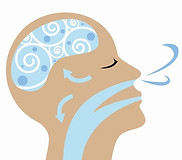Breathing Technique

Overview
If you are experiencing depression, you may benefit from practicing breathing techniques. These techniques can help regulate mood and reduce feelings of stress, anxiety, and restlessness. Some of the best known breathing techniques for people with or without bipolar disorder include deep breathing, controlled breathing, and alternating nostril breathing. These techniques work by activating the body's relaxation response and reducing the activity of the stress response, which can help improve overall mental health.
List of Breathing Techniques
Diaphragmatic breathing
This technique focuses on breathing from the diaphragm rather than the chest. It can help you relax and reduce stress.
Four-square breathing
This technique involves inhaling to the count of four, holding your breath for the count of four, exhaling to the count of four, and holding your breath again for the count of four. It can help you regulate your breathing and calm your mind.
Alternate nostril breathing
This technique involves closing one nostril and breathing in through the other, then closing that nostril and breathing out through the other. It can help you balance the two sides of your brain and calm your mind.
Progressive muscle relaxation
This technique involves tensing and relaxing each muscle group in your body, starting with your feet and working up to your head. It can help you relax your muscles and release tension.
Wim Hof breathing
This technique involves taking 30 deep breaths in a row, inhaling through the nose and exhaling forcefully through the mouth, in rapid succession without pausing. This is followed by a series of breath holding and deep inhalations, and you repeat this cycle 3 times.
To get started
-Choose a technique that you think will work well for you. You may want to try a few different techniques to see which one you prefer.
-Find a quiet, comfortable place to sit or lie down.
-Begin by taking a few deep breaths to help you relax.
-Follow the instructions for your chosen breathing technique.
-Practice the technique for a few minutes, focusing on your breath and letting go of any distracting thoughts.
-When you feel ready, gradually return to your normal breathing pattern.
-You can practice the technique as often as you like, but it is generally recommended to start with a few minutes each day and gradually increase the length of your practice over time.
Some of the benefits include:
Reduction of negative thoughts and emotions
Focusing on your breath can help you shift your attention away from negative thoughts and emotions, which can help to reduce feelings of depression.
Improve mood
Slow, deep breathing has been shown to activate the parasympathetic nervous system, which can help to improve mood and reduce feelings of anxiety and stress.
Increase relaxation
Many breathing techniques are designed to help you relax, which can be especially beneficial for people with depression who may be experiencing a lot of tension and stress.
Improve sleep
Some breathing techniques, such as four-square breathing, can be helpful for people who have trouble sleeping. By focusing on the breath, you can relax your body and mind, which can help you fall asleep more easily.
Improve mindfulness
Breathing techniques can help you become more mindful and more present in the moment, which can be beneficial for people with depression who may feel disconnected or lost.
Studies and Videos References

Dr. Andrew Huberman & Dr.Jack Feldman: Breathing for Mental & Physical Health & Performance
https://www.youtube.com/watch?v=GLgKkG44MGo&t=1s&ab_channel=AndrewHuberman
Dr. Andrew Huberman: How to Optimize Your Brain-Body Function & Health
https://www.youtube.com/watch?v=rW9QKc-iFoY&ab_channel=AndrewHuberman
Guided Wim Hof Method Breathing
https://www.youtube.com/watch?v=tybOi4hjZFQ&ab_channel=WimHof
Wim Hof Method Guided Breathing for Beginners (3 Rounds Slow Pace)
https://www.youtube.com/watch?v=0BNejY1e9ik&t=11s&ab_channel=WimHof
Dr. Andrew Huberman: Tools for Managing Stress & Anxiety
https://www.youtube.com/watch?v=ntfcfJ28eiU&ab_channel=AndrewHuberman
Dr. Andrew Huberman - Breathing Exercises for Optimized Brain Performance
https://www.youtube.com/watch?v=OSwQSb-Cb7U&ab_channel=BrainMindSummit
Dr. Andrew Huberman Using Cortisol & Adrenaline to Boost Our Energy & Immune System Function
https://www.youtube.com/watch?v=JPX8g8ibKFc&t=2s&ab_channel=AndrewHuberman
Meditative movement for depression and anxiety
https://www.frontiersin.org/articles/10.3389/fpsyt.2013.00071/full
Establishing key components of yoga interventions for reducing depression and anxiety, and improving well-being
https://bmccomplementmedtherapies.biomedcentral.com/articles/10.1186/s12906-015-0614-7
Effects of deep breathing in patients with bipolar disorder
https://www.researchgate.net/profile/Flavia-Lima-7/publication/327486140_Effects_of_deep_breathing_in_patients_with_bipolar_disorder/links/5cd099d292851c4eab87d394/Effects-of-deep-breathing-in-patients-with-bipolar-disorder.pdf
CHARACTERISTICS OF USERS AND REPORTED EFFECTS OF THE WIM HOF METHOD : A MIXED-METHODS STUDY
http://essay.utwente.nl/76839/
Wim Hof Method Explained
https://www.thestll.com/articles/wim-hof-method-explained
Voluntary activation of the sympathetic nervous system and attenuation of the innate immune response in humans
https://www.pnas.org/doi/abs/10.1073/pnas.1322174111
The Effect of Deep and Slow Breathing on Pain Perception, Autonomic Activity, and Mood Processing
https://academic.oup.com/painmedicine/article/13/2/215/1936333
Mood change and perceptions of vitality: a comparison of the effects of relaxation, visualization and yoga.
https://www.ncbi.nlm.nih.gov/pmc/articles/PMC1293998/
Ultra-brief breath counting (mindfulness) training promotes recovery from stress-induced alcohol-seeking in student drinkers
https://www.sciencedirect.com/science/article/pii/S0306460319308366
Effects of Shambhavi Mahamudra Kriya, a Multicomponent Breath-Based Yogic Practice , on Perceived Stress and General Well-Being
https://journals.sagepub.com/doi/full/10.1177/2156587217730934
